
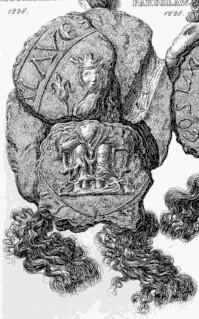 A medieval Rus’ princess travels west to start her new life as the bride of a Polish king, bringing westward, too, her natal Eastern Christianity that is increasingly at odds with the Western Church. One year after bearing her firstborn son, she suddenly finds herself widowed in this foreign land, her husband murdered. To protect her son’s right to the throne against the treacherous schemes of the child’s uncle, she acts as the young king’s regent and then unofficial advisor. Together with her son, she issues dozens of charters, influences economic matters, constructs a church, and carries out a wide range of political duties during a decisive time in Ukraine’s historical development.
A medieval Rus’ princess travels west to start her new life as the bride of a Polish king, bringing westward, too, her natal Eastern Christianity that is increasingly at odds with the Western Church. One year after bearing her firstborn son, she suddenly finds herself widowed in this foreign land, her husband murdered. To protect her son’s right to the throne against the treacherous schemes of the child’s uncle, she acts as the young king’s regent and then unofficial advisor. Together with her son, she issues dozens of charters, influences economic matters, constructs a church, and carries out a wide range of political duties during a decisive time in Ukraine’s historical development.
This is the story of Gremislava Ingvarovna, the 13th century Rus’ princess who is at the center of Dr. Talia Zajac’s ongoing research. Zajac, a Eugene and Daymel Shklar Research Fellow at HURI, earned her PhD at the Centre for Medieval Studies at the University of Toronto. She’s currently working on a project titled, “Forgotten Female Rulers of Medieval Europe: Reconstructing the Reigns of Ten Early Rus’ Queens, Noblewomen, and Princesses, 1000-1250.”
On Monday, March 26, 2018, she presented her initial findings at the Seminar for Ukrainian Studies. Through her research, she shows that uncovering the stories of influential women not only restores what history books forgot, but also provides information about influential events. Ahead of her talk, Zajac answered a few of our questions, offering a glimpse into the life, world, and impact of Gremislava Ingvarovna.
HURI: How did you become interested in medieval royal women? Why did you choose to focus on Gremislava?
Zajac: I first came to the topic of Rus’-born princesses who became the consorts of Western European rulers through popular histories of Anna Yaroslavna (d. 1075/1079), queen consort of King Henri of France (d. 1060) and regent for her son Philippe I (d. 1108). I was fascinated by the idea of a woman travelling across the length of Europe in the mid-eleventh century who brought into contact the cultures of France and Rus’. As I began to research Anna’s life, I learned that her experience was not entirely exceptional, since there were more than sixty marriages between the ruling clan of Rus’ and Western Christian rulers during the eleventh to thirteenth centuries. Yet I could not find much reliable information about these women. When these marriages are discussed in scholarship, they are often listed in the context of the “foreign relations” of Rus’; namely how a given woman’s marriage helped to cement an alliance of friendship or mutual military support between her father and her husband. There was little I could find on the experiences of the women themselves, and so I decided that it would be worth investigating this issue through further research.
Among the Rus’-born consorts of Western European men who deserve to be better known in Anglo-American scholarship is Gremislava Ingvarovna (d. 1258). In my opinion, her reign was as interesting and dramatic as those of better-known medieval female rulers, such as Eleanor of Aquitaine (d. 1204) or Blanche of Castile (d. 1252). Left a widow in a foreign land in 1227 by the sudden murder of her husband, Gremislava successfully defended her one-year-old son Bolesław’s claim to the throne of Kraków against the machinations of his uncle (her brother-in-law) Konrad of Mazovia (d. 1247). Throughout her son’s reign, she acted first as regent (1227-1228) and then as his unofficial adviser, leaving the greatest number of surviving documents of any Rus’-born princess who married into a Western European ruling house (forty-four charters that I have identified so far). Her activities spanned the economic fields as well. Together with her son, she jointly issued a charter re-establishing Kraków under Magdeburg Law in 1257, and constructed a church in honor of Saint Nicholas in the salt-mining town of Bochnia in the 1250s.
I chose to focus on Gremislava not only for her wide-ranging political activities and religio-cultural patronage, but also because studying her life deepens our knowledge of several watershed moments in Ukrainian history. Perhaps most importantly, her reign coincides with that of Prince and, after 1253, King Danylo Romanovich (d. 1264) and his brother Vasil’ko Romanovich (d. 1269) who ruled the southwest Rus’ principalities of Galicia and Volhynia, which neighbored Gremislava’s lands. From the work of Mykhailo Hrushevsky (d. 1934) onward, these Rus’ principalities, first united under the rule of prince Roman Mstislavich (d. 1205) in 1199 and then again by his son Danylo in 1245-1246, occupy a key place in the narrative of Ukraine’s historical development as they are often seen as an important “successor state” to Kyivan Rus’. Danylo and Vasil’ko were Gremislava’s cousins. She knew them personally, but often had a hostile relationship with them, mainly because they were allied with her enemy, her brother-in-law Konrad. Studying Gremislava’s reign therefore also sheds light on this period of early Ukrainian history.
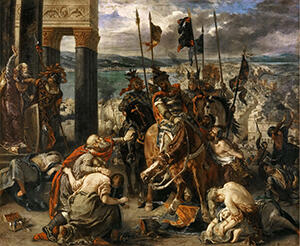 Gremislava’s reign also coincides with a number of important developments in Orthodox-Catholic relations, especially the establishment of the so-called Latin Empire by participants of the Fourth Crusade in 1204. Not only did the sack of Constantinople horrify Byzantine witnesses, but the long-term presence of Latin Christians in the city made divergences of belief and practice in Eastern and Western Christianity increasingly impossible to ignore. Indeed, most scholars now date the hardening of the Church Schism between Orthodoxy and Latin Christian to this period (1204-1261). Studying Gremislava’s reign allows us to investigate how developments in the medieval political center of Constantinople affected the lives of rulers on the so-called “periphery” of Christendom: in this case, relations between Rus’ and neighboring Poland. In fact, many scholars have argued that Gremislava even supported missions by Dominican and Franciscans friars to convert her relatives in Rus’ to Catholicism. While I do not see direct evidence supporting this claim, it does seem that during Gremislava’s lifetime previously amicable relations between the Rus’ and the Poles were coming under increased stress as religious differences between Orthodoxy and Catholicism were beginning to become harder to ignore.
Gremislava’s reign also coincides with a number of important developments in Orthodox-Catholic relations, especially the establishment of the so-called Latin Empire by participants of the Fourth Crusade in 1204. Not only did the sack of Constantinople horrify Byzantine witnesses, but the long-term presence of Latin Christians in the city made divergences of belief and practice in Eastern and Western Christianity increasingly impossible to ignore. Indeed, most scholars now date the hardening of the Church Schism between Orthodoxy and Latin Christian to this period (1204-1261). Studying Gremislava’s reign allows us to investigate how developments in the medieval political center of Constantinople affected the lives of rulers on the so-called “periphery” of Christendom: in this case, relations between Rus’ and neighboring Poland. In fact, many scholars have argued that Gremislava even supported missions by Dominican and Franciscans friars to convert her relatives in Rus’ to Catholicism. While I do not see direct evidence supporting this claim, it does seem that during Gremislava’s lifetime previously amicable relations between the Rus’ and the Poles were coming under increased stress as religious differences between Orthodoxy and Catholicism were beginning to become harder to ignore.
HURI: What were some of the “emerging” theological and religious differences of this time? In comparison, are the two Churches more or less like each other now?
Zajac: The Great Schism (the East-West Schism) has been traditionally dated to July 16th 1054 when Cardinal Humbert of Silva Candida (d. 1061), the legate of Pope Leo IX (r. 1049-1054), placed on the altar of Saint Sophia in Constantinople a bull excommunicating Patriarch Michael I Keroularios (r. 1043-1058), who responded in kind a few days later. Since at least the 1920s, however, scholars have argued that this date has been exaggerated in significance. Medieval contemporaries did not consider the mutual excommunications to mark the beginnings of a permanent divide in Christendom. Rather, scholars suggest that that only with the sack of Constantinople by crusaders in 1204 did East-West relations dramatically worsen, and even then, travellers, monks, and royal brides, helped to maintain an ongoing dialog between these two Christian traditions. When the ‘Schism’ became an actual hard reality is much more difficult to determine.
Nonetheless, the origins of liturgical, doctrinal, and legal differences between Eastern and Western Christianity go back centuries. For example in 691/692, Emperor Justinian II (r. 685-97, 705-711) organized an important Church council in Constantinople known as the Council in Trullo (from the Greek word for the “domed hall”, ho troullos, in which the council met), which is also called the Quinisext Council. Although the Council in Trullo has played an enormously influential role in the development of Byzantine canon law, its precepts were not accepted in the West. In fact, several of its decisions directly condemned practices that were gaining ground in the West, such as clerical celibacy (canon 13). Popes refused to sign their approval of this Council, while in Byzantine canon law its decisions became fundamental to subsequent Church legislation.
Another important point of tension came in the ninth century. Rivalry between Byzantine and Latin missionary groups over the conversion of Slavs in Moravia and the Balkans in the 860s led to Byzantines discovering firsthand differences of Byzantine and Latin theological teachings and ritual practice. Political tensions within Byzantium associated with the contested election of Patriarch Photios (r. 858-67, 877-886) and competition for ecclesiastical jurisdiction with the Latin Christian hierarchs for Bulgaria heightened religious tensions. As a result, in 867 Patriarch Photios I sent a letter to other Eastern bishops in which he condemned several practices of the Latin Church, especially the addition of the phrase “and the Son” (Filioque) to the Nicaean Creed (the dogmatic statement that the Holy Spirit proceeds from the Father and the Son). To some “hard-line” Byzantine clerics, the addition of words not included in the original formulation of the Creed by the Church Fathers at the First Council of Nicaea in 325 suggested that Western Christians did not hold correct views about the Trinity, or, in other words, that they were guilty of heresy. The use of Filioque in the Creed by the Western Church continues to be a source of unresolved dispute between the two traditions.
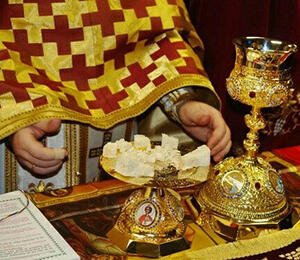 In the eleventh century, ritual differences also played an increased role in tensions between the two Churches. In particular, the Byzantine Church insisted on using leavened bread for communion, while the Latin Christian Church used unleavened bread. Although this difference may seem superficial, it was rooted in profound differences of ecclesiology, which is to say, how each tradition understood the nature of the Christian Church and its relationship to Judaism. For Byzantine clerics, using unleavened bread (in Greek: azyma) was wrong. It meant that Christians were continuing the Jewish practice of eating matzo bread, associated with the Exodus out of Egypt. In the view of Byzantine clerics, leavened bread symbolized the New Covenant instituted for Christian believers by Christ at the Last Supper while unleavened bread symbolized the “burden” of the Law that Christians should reject. Moreover, beginning in the eleventh century, Greek texts began to justify the Byzantine Church’s own use of leavened bread for Communion in terms of liturgical theology (yeast became symbolic of Christ’s Resurrection and so bread without yeast was “dead”). Leaven, which symbolically gave life to bread, was compared by Byzantine theologians to the soul which gave life to the body.
In the eleventh century, ritual differences also played an increased role in tensions between the two Churches. In particular, the Byzantine Church insisted on using leavened bread for communion, while the Latin Christian Church used unleavened bread. Although this difference may seem superficial, it was rooted in profound differences of ecclesiology, which is to say, how each tradition understood the nature of the Christian Church and its relationship to Judaism. For Byzantine clerics, using unleavened bread (in Greek: azyma) was wrong. It meant that Christians were continuing the Jewish practice of eating matzo bread, associated with the Exodus out of Egypt. In the view of Byzantine clerics, leavened bread symbolized the New Covenant instituted for Christian believers by Christ at the Last Supper while unleavened bread symbolized the “burden” of the Law that Christians should reject. Moreover, beginning in the eleventh century, Greek texts began to justify the Byzantine Church’s own use of leavened bread for Communion in terms of liturgical theology (yeast became symbolic of Christ’s Resurrection and so bread without yeast was “dead”). Leaven, which symbolically gave life to bread, was compared by Byzantine theologians to the soul which gave life to the body.
For medieval Latin Christians, the opposite was true: they interpreted the Last Supper as a Passover meal. Indeed, some, like Cardinal Humbert in the eleventh century, argued that since Jesus had to be sinless in order to die for the sins of mankind (otherwise He would have been dying for His own sins, not the world’s), He therefore had to have fulfilled perfectly all the requirements of Jewish Law, including the eating of matzo bread at Passover. The use of leavened versus unleavened bread in Communion therefore became not only a matter of different customs in the Byzantine and Latin Churches, but also reflected how each Christian tradition, Eastern and Western, saw Christianity in relation to Judaism.
In the eleventh century, differences also emerged between Latin and Byzantine understandings of role of the pope as leader over all other bishops of the Church (the theory of “papal primacy”). Advocates of a series of Western Church reforms, often called the “Gregorian Reforms” after one of their most famous proponents, Pope Gregory VII (r. 1073-1085), developed a broader understanding of papal primacy during this time, such as the right of the pope not only to depose bishops, but also emperors. An expanding understanding of papal primacy was further developed in the thirteenth century. Beginning with Innocent III (r. 1198-1216), popes saw themselves not only as the Vicar of Saint Peter, but as the Vicar of Christ with full temporal power over all lands on earth. Consequently, from Innocent III onwards, thirteenth-century popes began to demand recognition of papal primacy in this new sense from Orthodox communities. By contrast, Orthodox clerics had a different understanding of papal authority. To simplify, the Byzantine Church saw ultimate authority for defining Church dogma as resting in an ecumenical Church council, rather than in the person of the pope. Nonetheless, Byzantine clerics held the bishopric of Rome in particular honor due its position as the former center of the Roman Empire, and as the alleged site of Saints Peter’s and Paul’s martyrdoms. They characterized papal primacy differently. Rome was given special precedence and honor as a kind of first among equals in the “pentarchy,” the five ancient patriarchates of the ancient Christian world, with the others being Constantinople, Alexandria, Antioch, and Jerusalem.
By the early modern period, Byzantine canonists fixed five main points of unresolved differences between Orthodoxy and Catholicism: 1) the Latin addition of the Filioque to the Creed, 2) the notion of papal primacy, 3) the use of leavened (Eastern) or unleavened bread (Western) in the Eucharist, 4) disagreement on whether it is the prayer of invocation of the Holy Spirit (Greek: epiklēsis) or the words of the Institution (Jesus Christ’s words at the Last Supper, “Take, eat, This is My Body …”) that essentially complete the consecration of the Eucharist (the believed transformation of bread and wine into the Body and Blood of Christ), and 5) the validity of the Western doctrine of purgatory (first explicitly formulated by the Latin Church in the twelfth century). These points remain unresolved today. Nonetheless, ecumenical dialogue between Eastern and Western Christianity has never entirely disappeared. During the Middle Ages, inter-marriage certainly was one means by which dialogue continued.
HURI: Were members of the ruling class concerned with theological or ecclesiastic differences? How aware were they of the distinctions between the Churches?
The short answer is: yes and no. On the one hand, of course members of the ruling class would not have been trained in the nuances of theology. Their membership in the highest social strata of medieval society linked them to a cosmopolitan court culture that to a degree transcended confessional boundaries. Latin, Old Norse, and Old East Slavic narrative sources frequently emphasize the common Christianity of the Rus’ and their Western European neighbors in contrast to pagans or non-Christians. For example, according to the thirteenth-century Galician-Volhynian Chronicle, in 1246 the Rus’ prince Vasil’ko Romanovich urged his older brother Danylo to make an alliance with King Béla IV of Hungary (r. 1235-1270) against the non-Christian Mongols because he considered Béla to be also a “Christian” (“khr[i]stïan”). Their alliance was sealed by the marriage of Danylo’s son Lev (d. 1301) to Béla’s daughter Constance (d. circa after 1287/1288) in that year.
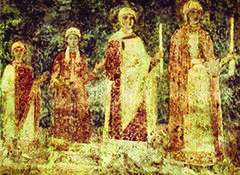 On the other hand, the ruling clan of Rus’ was also closely linked to the ecclesiastical hierarchy, with which they were expected to co-operate in the governance of their (at least nominally) Christian subjects. The rulers of Rus’, like Western Christian kings, had a sacral character to their authority: In the words of Metropolitan Nikifor of Kyiv in 1113 the prince was an “icon of Christ,” an earthly reflection of the Heavenly Ruler. By the turn of the first millennium, Christian identity was a key source of legitimacy for most ruling houses, and so rulers of any Christian land would have been aware of “belonging” to a certain Church tradition. Both elite men and women patronized monasteries, endowed churches, and, in the case of the ruling princes of Rus’, also issued church statues. A princess in Rus’ could also be commemorated formally as ktitor (donor / benefactor) of a church or monastery, linking her formally and ritually with the Byzantine Church. Her role as ktitor could be honored by a donor portrait in the interior of a church (an example is the eleventh-century donor portrait of Yaroslav the Wise’s wife and daughters in Kyiv’s Saint Sophia Cathedral). As ktitor, she could also be formally commemorated in the prayers of the Divinity Liturgy together with members of the Church hierarchy. In this way, her role as Christian patron linked her intimately to one particular form of Christianity and its clerical representatives.
On the other hand, the ruling clan of Rus’ was also closely linked to the ecclesiastical hierarchy, with which they were expected to co-operate in the governance of their (at least nominally) Christian subjects. The rulers of Rus’, like Western Christian kings, had a sacral character to their authority: In the words of Metropolitan Nikifor of Kyiv in 1113 the prince was an “icon of Christ,” an earthly reflection of the Heavenly Ruler. By the turn of the first millennium, Christian identity was a key source of legitimacy for most ruling houses, and so rulers of any Christian land would have been aware of “belonging” to a certain Church tradition. Both elite men and women patronized monasteries, endowed churches, and, in the case of the ruling princes of Rus’, also issued church statues. A princess in Rus’ could also be commemorated formally as ktitor (donor / benefactor) of a church or monastery, linking her formally and ritually with the Byzantine Church. Her role as ktitor could be honored by a donor portrait in the interior of a church (an example is the eleventh-century donor portrait of Yaroslav the Wise’s wife and daughters in Kyiv’s Saint Sophia Cathedral). As ktitor, she could also be formally commemorated in the prayers of the Divinity Liturgy together with members of the Church hierarchy. In this way, her role as Christian patron linked her intimately to one particular form of Christianity and its clerical representatives.
Some differences between Western and Eastern Christianity would have been immediately obvious to a princess from Rus’ who married a Latin Christian ruler or vice versa. Walking into a Western Christian Church, a Rus’ princess would first of all encounter a liturgy that was not in Old Church Slavonic, but in Latin. By the thirteenth century, she might see a building in a Gothic style which differed markedly from the architecture of Rus’ and might encounter a number of saints who were not venerated in her natal land, such as Saint Francis (canonized in 1228). Many feast and fast days would be different, and she would be surprised to find that Western parish priests were supposed to be celibate, rather than married. But it is more difficult to assert when rulers began to perceive differences between Eastern and Western forms of Christianity as not just different, but as wrong.
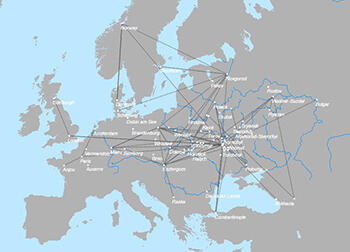 HURI: You’re probably well aware of Christian Raffensperger’s book Ties of Kinship and his contribution to our MAPA: Digital Atlas of Ukraine project. Where does your research fit into that story? (Gremislava doesn't appear on MAPA because she came after the time period covered by the map.)
HURI: You’re probably well aware of Christian Raffensperger’s book Ties of Kinship and his contribution to our MAPA: Digital Atlas of Ukraine project. Where does your research fit into that story? (Gremislava doesn't appear on MAPA because she came after the time period covered by the map.)
Zajac: I fully agree with Raffensperger’s conclusions that Rus’ was integrated in many ways with the rest of medieval Europe—politically, economically, dynastically. While Ties of Kinship and the MAPA project places the marriages of the ruling clan of Rus’ in the broader pan-European context of the many links Rus’ had with Western Europe and Byzantium, I zero in on the experiences of individual female rulers within these marriages over a longer period, from the eleventh century to the Mongol invasion of Rus’ (to around 1240/1241). To do so, I look in particular at evidence from Latin charters and letters written or issued by these Rus’ brides in Orthodox-Latin Christian marriages, as well as evidence from material culture such as prayer books, seals, or precious cloth associated with these brides. I am interested in exploring the ways in which women in Orthodox-Latin Christian marriages experienced religious differences and served as vectors for ongoing religio-cultural exchanges between these faith traditions.
HURI: Does information about these rulers change the way we view history, and how we think about religion, politics, and women today?
Zajac: Imagining Rus’ women in as varied locations as Anglo-Saxon England (Agafia Yaroslavna), Germany (Eupraxia Vsevolodna), France (Anna Yaroslavna) or Poland (Gremislava Ingvarovna , among many others) changes our mental picture of what medieval Western European court culture looked like. The physical presence of Rus’ princesses at Western European courts can be considered as an important means by which Orthodox and Latin Christian cultures remained in contact, despite the emergent differences discussed above. In this way, my research challenges the tendency to associate Western and Eastern Europe with mutually exclusive Catholic and Orthodox cultural spheres.
Finally, in today’s political climate, when some media outlets speak of a traditional “Orthodox” sphere of influence or even revive the idea of “holy Russia” (often conflated with Rus’), it is helpful to look at women who moved between cultures and between different expressions of faith, since they challenge the historically anachronistic notion of an unchanging, constant Orthodox cultural presence in Eastern Europe in general, and in Ukraine in particular.
The lives of these women, who crossed religious, linguistic, and cultural boundaries through their marriages, offer an important means for understanding the shared history of Eastern and Western Europe.
HURI: What is the most interesting or surprising thing you’ve learned so far in your research?
One thing that does surprise me is that sources of the eleventh to thirteenth centuries say next to nothing about these women’s entourages. A well-born woman whether coming to Rus’ or travelling from Rus’ would not have set out alone. But we do not know anything about ladies-in-waiting or servants who likely accompanied them and what happened to these persons. Did they marry locally and integrate into the local court culture or did they return to Rus’ after a time? The silences of the sources themselves invite further reflection.
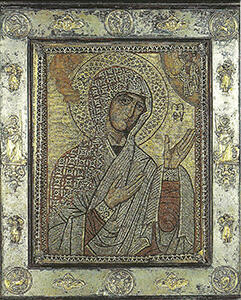 HURI: Is there anything else we should know?
HURI: Is there anything else we should know?
I would say that visual culture associated with Rus’ brides has not yet been fully explored as a potential source of information, which can further our knowledge of cross-cultural exchanges facilitated by marriages between the ruling clan of Rus’ and Western European dynasties. I say “associated” because part of the problem is that often it cannot be proven absolutely that a given Rus’ bride owned a particular object. Nonetheless, visual culture within a Rus’ bride’s personal network can indeed offer tantalizing suggestions of ongoing inter-confessional interaction. For example, Ulla Haastrup and John Lind have discussed in detail the appearance of certain Byzantine features in frescoes found in Danish churches that date to the 1120s, which they argue stemmed from the connections to Byzantium and Rus’ established in the circle of Queen Margareta Fredkulla of Denmark (d. 1130) and her nieces, the Rus’ princesses Malmfrid Mstislavna (d. after 1135) and Ingeborg Mstislavna (d. after 1131). The use of Byzantine iconography in these churches suggests that these two Rus’ sisters continued to experience continuity with the religious traditions of their natal land after their marriages to Scandinavian rulers.
Another example might be an exquisite late twelfth/ early thirteenth century mosaic icon of the Mother of God currently located in the treasury of the Poor Clare Sisters in Kraków. According to the earliest inventories of the monastery (written in 1718, 1729, 1759, 1773, and 1793), these nuns received this icon from their foundress, Salomea, whose mother was Gremislava Ingvarovna . Salomea may have received this icon in Rus’ or through her mother-in-law, the Byzantine princess Maria Laskarina. If the mosaic icon can indeed be linked authentically with Gremislava and Salomea’s family, then it tell us something about visual culture at the court of Kraków, which continued to value Orthodox devotional objects, even as Eastern and Western forms of Christianity moved further apart.